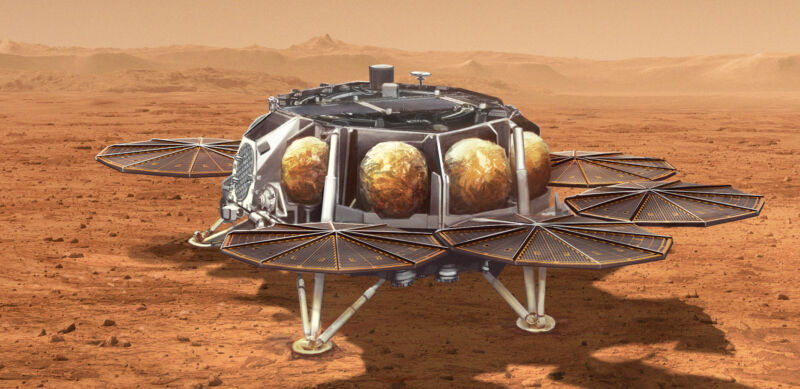Title: NASA’s Mars Sample Return Mission Faces Doubled Costs and Delays
Date: Jun 23, 2023
NASA’s ambitious plan to bring back rocks from Mars to Earth, known as the Mars Sample Return (MSR) mission, is facing significant challenges as costs have doubled and delays are expected. The project, which has been a top priority for NASA and the scientific community, threatens to consume the agency’s science budget.
Former chief of NASA’s science programs, Thomas Zurbuchen, expressed his concerns about the mission, stating that it gave him sleepless nights during his tenure. Zurbuchen, who left NASA at the end of 2022, believes there is a crisis surrounding the project.
Recent briefings by the Program Manager for the mission, Richard Cook, and the director of the mission at NASA Headquarters, Jeff Gramling, revealed that the development cost for the MSR mission has skyrocketed from $4.4 billion to an estimated $8 to $9 billion. This figure only covers the cost of building and testing the mission’s components and does not include launch costs, operating costs, or the construction of a sample-receiving facility.
The total cost of the MSR mission is now estimated to be around $10 billion, making it one of NASA’s most expensive science missions to date.
The MSR mission aims to return material from Mars to better understand the planet’s geological history and search for evidence of past or present life. NASA, along with its international partners, including the European Space Agency, settled on the current design of the mission last summer.
The plan involves developing a large “Sample Retriever Lander” that is scheduled to launch in 2028. The Perseverance rover, which landed on Mars in 2021, will collect and store samples of Martian dust in titanium tubes. However, due to concerns about the rover’s longevity, NASA plans to send two helicopters as a backup plan to retrieve the samples.
Once the samples are delivered to the lander, they will be placed aboard the Mars Ascent Vehicle, a rocket developed by Lockheed Martin. The rocket will launch from Mars and release the “Orbiting Sample container” into Martian orbit. The European Space Agency

How will the significant increase in the Mars Sample Return mission’s budget impact NASA’s science budget and future missions
NASA’s Mars Sample Return Mission Confronts Increased Costs and Delays
Date: Jun 23, 2023
NASA’s ambitious endeavor to bring back rocks from Mars to Earth, known as the Mars Sample Return (MSR) mission, is encountering significant obstacles as costs have doubled and delays are on the horizon. This project, which has been of utmost importance to NASA and the scientific community, threatens to deplete the agency’s science budget.
Former chief of NASA’s science programs, Thomas Zurbuchen, shared his apprehensions about the mission, admitting that it caused him countless sleepless nights during his tenure. Zurbuchen, who concluded his service at NASA at the end of 2022, strongly believes that a crisis surrounds the project.
Recent briefings by the mission’s Program Manager, Richard Cook, and the director at NASA Headquarters, Jeff Gramling, divulged that the development cost for the MSR mission has skyrocketed from $4.4 billion to an estimated $8 to $9 billion. This sum solely encompasses the expenses related to constructing and testing the mission’s components and does not factor in launch costs, operating costs, or the creation of a sample-receiving facility.
The overall expenditure for the MSR mission is presently projected to be approximately $10 billion, rendering it one of NASA’s most financially demanding science missions to date.
The primary objective of the MSR mission is to procure material from Mars in order to enhance our comprehension of the planet’s geological history and to search for indications of past or present life. NASA, alongside its international partners, including the European Space Agency, settled on the current mission design last summer.
The plan revolves around the development of a sizable “Sample Retriever Lander” scheduled to launch in 2028. The Perseverance rover, which successfully landed on Mars in 2021, will collect and preserve samples of Martian dust in titanium tubes. However, due to concerns regarding the rover’s durability, NASA intends to dispatch two helicopters as a contingency plan to retrieve the samples.
Once the samples have been delivered to the lander, they will be loaded onto the Mars Ascent Vehicle, a rocket constructed by Lockheed Martin. The rocket will then launch from Mars and release the “Orbiting Sample container” into Martian orbit. The European Space Agency will subsequently collaborate with NASA to dispatch a spacecraft to retrieve the sample container from orbit and bring it back to Earth for analysis.

The ambitious Mars Sample Return Mission by NASA faces significant challenges and setbacks, as the costs double. However, setbacks are an inevitable part of pioneering exploration, and I trust that NASA’s resilience and determination will lead to invaluable discoveries and advancements in our understanding of the red planet.
The road to Mars is getting steeper for NASA’s Sample Return Mission as costs soar and obstacles mount. Will the agency find innovative solutions and secure the necessary funding to overcome these challenges? The success of this ambitious mission is crucial to unlocking the mysteries of the red planet.